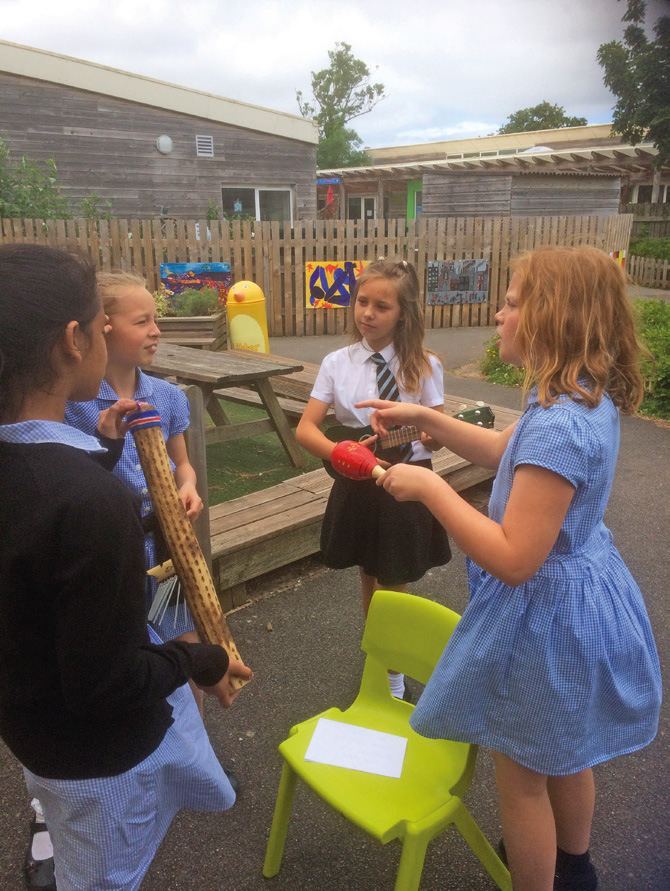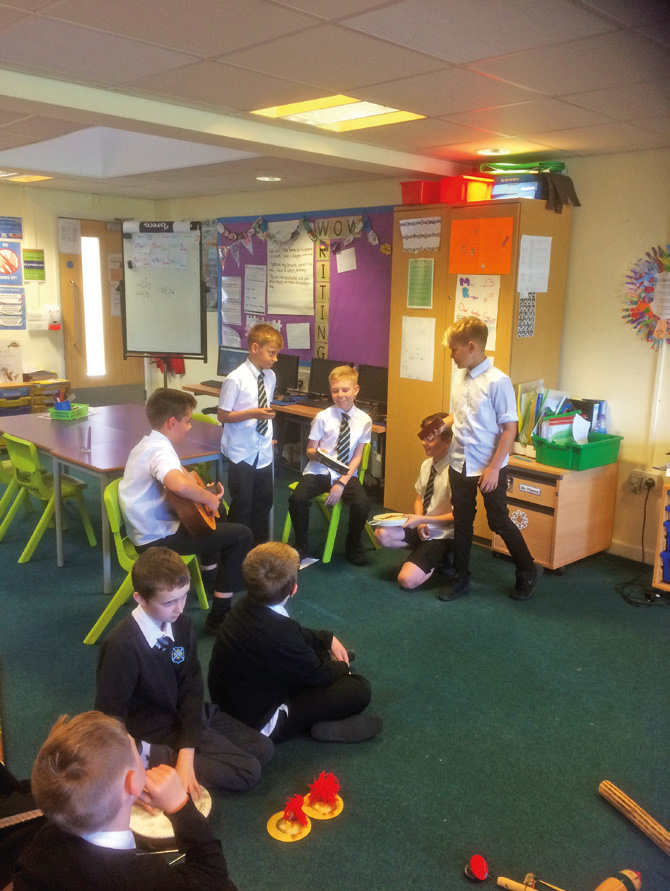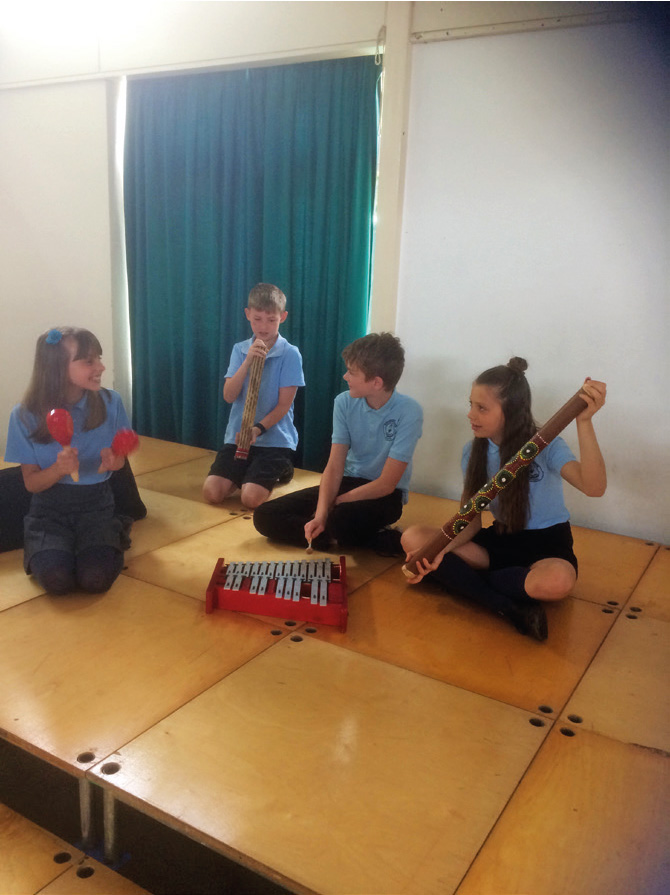
In the spring term, I undertook a five-week composition project with three classes of Year 5 children from three schools in South Devon. The theme of the project was ‘The Teignmouth Electron’ – the story of an ill-fated navigator who entered a prestigious yacht race in 1968, cheated brazenly and eventually came to grief in the South Atlantic. This is a local story with local roots.
My resources were the story itself, the school instruments at my disposal and my own violin, guitar and voice. And my plan was straightforward: to facilitate the composition of five instrumental pieces, each relevant to the experience of the sailor in question – ‘The Wind in the Sails’, ‘Becalmed’, ‘Beneath the Waves’, ‘Despair’, and ‘Tropical Island’ (the boat was eventually dumped on a beach in the Caribbean) – and to incorporate these into a musical telling of the story. A ‘mini-musical’, if you like.
Facilitating this kind of work, in which large groups of children subdivide and compose in noisy groups towards musical outcomes, is acoustically and logistically demanding. In my favour, however, was a gripping story about the children's home town, which held the attention and captivated the imagination, and three groups of wonderfully exuberant, musical children. To what extent did I need to lead them, and to what extent could I let their imaginations run riot? How could I get this balance right?
The process unfolded as follows…
Opening session
The excitement of the story and imminent opportunity for the pupils to get their hands on the instruments elicits an initial exuberance which immediately threatens to derail the process. The children are overexcited, and that excitement manifests physically. This is of course a good thing, because excitement is an expression of desire, desire is naturally expressed through physicality, and physicality is an important ingredient of musical creativity. We are, after all, going to play this music with our arms and hands, not just think about it. So let's not subdue them too fiercely, but rather try to channel that enthusiasm! In the first session, my work is all about demonstrating how to balance the random shaking and striking of our instruments with structural integrity, through the use of simple compositional ideas. Music lessons may need to begin with a period of experimental random bashing – this is step one in the creative process. Such a beginning can be made to morph into something more purposeful through questioning:
- If you hit the cymbal less hard, how might that help the bell player?
- How can you change your sounds so that each player can hear the other?
- What might be the role of this very quiet instrument which we can't hear at the moment?
- Can you experiment with ways to use your sounds individually, or in pairs, or threes?
- Imagine you are on a becalmed sea, lying on the deck beneath the blazing sun – what sounds do you want to play to evoke this? Loud, quiet, long, short, metallic, wooden, shaken, struck?
Simple questions such as these have the effect of calming the composers and guiding them in their experiments, so that they begin to understand the nature of composition as sound that is expressively purposeful. It is important to understand, however, that the making of sound as a raw material is a legitimate starting point. Young composers need to experiment before they can begin to design. My job is to illuminate the aural experimentation through my questions.
The process is a delicate balance of the children's brazen physicality and my interjections. As the questioning progresses, so the sense of purposeful sound-making increases. I intersperse short periods of free-for-all music-making with silent pauses in which I try to model musical ideas on my violin and ask musical questions of the groups, allowing them to experience the power of a single musical idea in the shaping of a piece. Then it's back to noisy group work again. Through this process of continually ‘hitting the pause button’ and then releasing it, the musical intent in the room gradually becomes more meaningful, until the majority are engaged constructively in both the doing of and the thinking about their composing.

Pratt worked with students from three South Devon primary schools on this project
Experimenting to composing
The second session is different to the first. The groups can start immediately on their projects without any preamble. The noise level is more controlled because the initial euphoric experimentation is ‘out of their systems’, and the ideas from session one are recalled as starting points. Now the composition questions can become more sophisticated:
- Can you create a short repeating tune on a xylophone to underpin your maraca and drum sounds? (a question of pitch).
- How can you use that harmonica pattern with the bells? (a question of timbre). Can I hear just those two instruments?
- How might you layer your sounds so that each musician is heard? (a question of texture)
- How will you start and stop? (a question of sound and silence).
The questions become more sophisticated as the music starts to gain structural and expressive power. The link between a theme (such as ‘becalmed’) and a musical idea (long, low notes, gradually layering over each other) becomes deeper. The music becomes programmatic and speaks of the theme, albeit in sometimes nebulous ways. Although we are composing music which is programmatic in its design, it doesn't matter how tenuous the relationship between theme and music; that relationship is simply a structural device to encourage children to think of sound as malleable and expressive. The exuberance of session one is now tempered by the thrill of expressive musical ownership. We have graduated from experimenting to composing.
When to stop
There is a limit to the holding power of this creative process, and in session three we reach it. There is a sense that we have finished, and this is conveyed through a desire to trial some potentially unhelpful ideas:
- Can I swap groups?
- Can we change all our instruments?
- Can we do another bit of the story?
- We don't like ours any more, can we do something different?
To the adult, these ideas seem unhelpful. There is a sense that the children want to undermine their work by discarding it wholesale, or go in the opposite direction by ‘gilding the lily’; smothering their work with too many new designs.
The children's sense, however, might be that the creativity can go on and on and on, just as it might have done when they played freely in the music corner in reception class. Why, from their point of view, should there be an end to the process? They might view the destruction of their piece as creative too! They don't necessarily cherish it as a finished entity because they can't literally see it, as they might a sculpture or painting. Creative ideas are desirable, up to a point, but they can also start to undermine if allowed too free a rein. We can play (in the musical and childlike sense of the word) for ever and ever, but eventually we might want to stop and stand back from our creation and say it is a finished thing. The danger of not doing so is akin to a chef putting just too many tasty elements on the plate. We can go on and on – but when is our product enough?

Success comes from utilising the student's raw enthusiasm, not working against it
This is a difficult but fundamental question, a judgement call. I can ask the children if their work is finished, and they may say yes. Then I have a choice laced with artistic power: I can agree that it is finished, or I can argue that it is not. If I take the latter course, I must have reasons for my decision, and suggestions to hand. Having these suggestions depends on my own creative integrity as a music teacher. I need to have a reason to justify my decision. I need to genuinely believe it is not finished, for artistic reasons, otherwise the children may see through my falsehood (‘he's only saying that because he doesn't know what to tell us to do next!’).
In my experience, children very quickly pick up on disingenuous reasoning. If I have no ideas about improving the piece, then it is finished. Children will only continue to refine what they have already created if they are still motivated to do so, and the teacher is responsible for that motivation through their musical wisdom. This doesn't mean that all music teachers need to be Mozartian geniuses; it simply means that we need to have constructive musical ideas.
Reflection and preparation
Session four is about reflection, consolidation, refinement and final preparation, because we will be performing live in session five. This is a session in which expectations for the performance are intentionally heightened. We think ahead to every nuance of session five: where we will sit, where the audience will sit, what the lighting will be, how we will incorporate the soundscapes into the story, what feedback we might ask for, and so on.

By the time students perform for each other, a sense of mutual support has been built
There is scope in this session to hear each other's work; to participate as performer or audience and to understand those roles. It is a dress rehearsal situation. In this session the senses are intensified as we ‘listen with concentration and understanding’ (National Curriculum, 2014) and help each other to prepare. The fourth session is often the calmest: there is no sound pollution because each group works separately to a ‘practice’ audience. There is a sense of reverence as we hear other work for the first time and there is a sense, too, of mutual support. We have all composed – we all know how hard but rewarding it is – and we have a better understanding of how sound experimentation morphs, through doing and thinking, into music.
Performance and reflection
The performance session is about them and us: those of us who offer, and those who receive. It is the culmination of our illumination of raw sound.
How many times, as teachers, do we hear the old arguments around the question of child-led versus teacher-led experiences; the arguments of free-thinking educationalists such as the Regio Emilia School, versus the data-driven approaches of 21st-century state education?
These arguments attempt to examine to what extent education is a personal or impersonal journey. I hope that this description of a musical process may go some way to suggest that we may be asking the wrong question here. Through the process of musical composition we can see that the question is not so much whether the work is child-led or adult-led, but rather whether the ongoing relationships between teacher and pupil – and between the pupils themselves – are healthy.
The truth is that good music teaching is always about both the joy of experimentation, and the wisdom to make refinements. Children have the former in spades, but the latter is principally the domain of the teacher. The trick is to interlock both processes and to be able to move seamlessly from one to the other. The process is not one of the leader and the led, but rather one in which the children's experimentation and the teacher's ability to refine have equal status. The wise teacher knows this and has the skill to allow for it. The children sense this wisdom and allow the teacher psychological space to be effective. This requires the teacher's empathy, their most powerful tool. When the teacher models empathy they increase their chances of experiencing it reciprocally.
In this harmonious state, questions of ‘leader’ or ‘led’ become irrelevant.
In the light of these ideas, we might step beyond this old duality and lay a philosophical foundation for children's musical composition:
- That the process is underpinned by desire, and that the desire is managed through the teacher's knowledge of how to refine, and an understanding of the balance between refinement and experimentation
- That the musical process is managed through the progression from unstructured sound, morphing into expressive and meaningful structures, by way of the teacher's musical questions
- That the teacher has the wisdom to understand the process from the child's point of view, and can understand and support questions such as when a piece is finished or not
- That the teacher is empathetic in their handling of artistic power: that they sense when to lead and when to be led.
Kip Pratt is a creative project leader and lecturer in primary education (music) at Plymouth University








